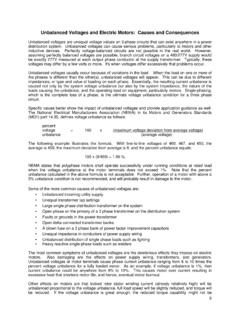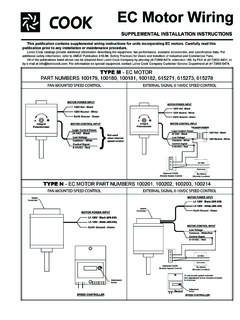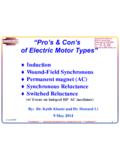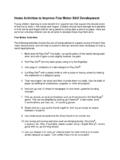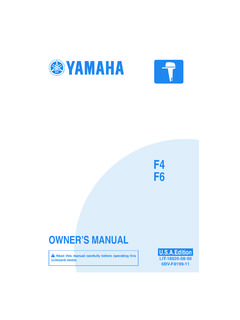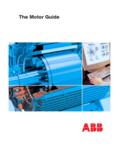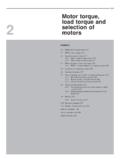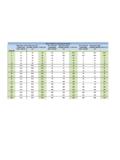Transcription of What Do All Those Things on an AC Motor …
1 what Do All Those Things on an AC Motor Nameplate Mean? Introduction: Ever order a Motor on power, speed, and enclosure? PO says maybe "5 hp, 1,800 rpm, TEFC.". New- Motor nameplate says "HP 5, RPM 1748, Enclosure TEFC, Des B, Frame 184T, Amps , PH 3, HZ 60, Duty Cont, Volts 460, Type P, Amb 40 C, SF , INS CL F, EFF , 80, DE. bearing 35BC02 JGG30A26, ODE bearing 3 OBC02 JGG3OA26.". Should you reject the Motor because it is not rated at 1,800 rpm? what does all that extra information on the nameplate mean? Do you care? The answers are "maybe," "we'll discuss it in a minute," and "you probably should.". To define the basic performance and mounting parameters of a Motor , the National Electrical Manufacturers Association (NEMA) defines some basic design and dimensional parameters in NEMA Standard MG 1. These parameters are then coded onto the Motor nameplate to give you a basic definition of what you have received.
2 Manufacturers often include additional information to further define some key Motor features. Section MG , "Nameplate Marking for Medium Single-Phase and Polyphase Induction Motors," of the NEMA standard requires that "The following minimum amount of information shall be given on all nameplates of single-phase and polyphase induction motors. For abbreviations, see MG ". * Manufacturer's type and frame designation * Horsepower output. * Time rating. (See MG ). * Maximum ambient temperature for which Motor is designed. (See Note I of MG ). * Insulation system designation. * RPM at rated load. * Frequency. * Number of phases. * Rated load current. * Voltage. * Code letter for locked rotor kVA. (See MG ). * Design letter for medium motors. (See MG ). * NEMA nominal efficiency when required by MG 1- * Service factor if other than * For motors equipped with thermal protectors, the words "thermally protected" if the Motor provides all the protection described in MG (See MG and MG ).
3 * For motors rated above 1 hp equipped with over-temperature devices or systems, the words OVER TEMP. " A type number as described in MG 1- inserted in the blank would identify the protection type. The information on a Motor nameplate can be arranged in categories. By definition, an induction Motor converts electrical energy to useful mechanical energy. With rated electrical input the Motor will deliver rated output shaft power. There are established standard indicators of how effective the Motor does its job, as well as data on the nameplate concerning safety and reliability. The following information provides a brief definition and some application considerations regarding Motor data on the nameplate. Electrical Input Voltage The voltage at which the Motor is designed to operate is an important parameter. Standard voltage for motors built to NEMA MG 1 (1987) are defined in MG One common misapplication is of motors nameplated (rated) at one voltage but applied on a different voltage network using the + 10% voltage tolerance for "successful" operation.
4 Nameplate-defined parameters for the Motor such as power factor, efficiency, torque, and current are at rated voltage and frequency. Application at other than nameplate voltage will likely produce different performance. It is common for manufacturers to nameplate a wide variety of voltages on one Motor nameplate. A common example is a Motor wound for 230 and 460 V (230/460 V) but operable on 208 V. This 208-230/460 V Motor will have degraded performance at 208 V. Another common misconception is to request a Motor rated at network voltage; for example, at 480 V. The NEMA standard is 460. V. The voltage rating assumes that there is voltage drop from the network to the Motor terminals. Thus, the 460-V Motor is appropriate on a 480-V network. Frequency Input frequency is usually 50 or 60 Hz. When more than one frequency is nameplated, other parameters that will differ at different input frequencies must be defined on the nameplate.
5 The increasing use of adjustable frequency drives (AFDs) is also making it necessary to nameplate a frequency range, especially for hazardous-duty-listed applications. Phase This represents the number of ac power lines supplying the Motor . Single and three-phase are the norms. Current Rated load current in amps is at nameplate horsepower (HP) with nameplate voltage and frequency. When using current measurement to determine Motor load, it is important that correction be made for the operating power factor. Unbalanced phases, undervoltage conditions, or both, cause current to deviate from nameplate AMPS. Review both Motor and drive for a matched system regarding current on AFD applications. Code A letter code defines the locked rotor kVA on a per-hp basis. Codes are defined in MG by a series of letters from A to V. Generally, the farther the code letter from A, the higher the inrush current per hp.
6 A replacement Motor with a "higher" code may require different upstream electrical equipment, such as Motor starters. Type NEMA MG 1 requires manufacturer's type, but there is no industry standard regarding what this is. Some manufacturers use "Type" to define the Motor as single or polyphase, single or multispeed, or even by type of construction. Type is of little use in defining a Motor for replacement purposes unless you also note the specific Motor manufacturer. Power factor Also given on the nameplate as " " or PF," power factor is the ratio of the active power (W) to the apparent power (VA) expressed as a percentage. It is numerically equal to the cosine of the angle of lag of the input current with respect to its voltage, multiplied by 100. For an induction Motor , power factor also varies with load. The nameplate provides the power factor for the Motor at full load.
7 Active power is the power that does work; apparent power has a reactive component. This reactive component is undesirable - the utility company must supply it, but it does no work. A. power factor close to unity (100%) is most desirable. Because there are tradeoffs when designing an induction Motor for improved efficiency or other performance parameters, power factor sometimes suffers. It can be improved by adding capacitors. Capacitor correction The nameplate may list the maximum power-factor correcting capacitor size. Nameplate notation would be something like "MAX CORR KVAR" followed by a number. The number would indicate capacitor value in kilovars. A value greater than that suggested may result in higher voltages than desired and could cause damage to the Motor or other components. Mechanical Output Horsepower Shaft horsepower is a measure of the Motor 's mechanical output rating, its ability to deliver the torque required for the load at rated speed.
8 It is usually given as "HP" on the nameplate. In general: HP = (Torque) x (speed)/5,250 where: Torque is in lb-ft Speed is in rpm Full-load speed The speed at which rated full-load torque is delivered at rated power output is full-load speed. It is generally given as "RPM" on the nameplate. This speed is sometimes called "slip" speed or actual rotor speed rather than synchronous speed. Synchronous speed is the speed at which the Motor would run if it were fixed to the ac power line frequency; that is, if it turned at the same speed as the rotating magnetic field created by the combination of winding pattern and power line frequency. An induction Motor 's speed is always less than synchronous speed and it drops off as load increases. For example, for 1800 rpm synchronous speed, an induction Motor might have a full-load speed of 1748 rpm. There have been conflicting opinions and claims regarding the effect of replacing a "standard- efficiency" Motor with an "energy-efficient" Motor on a centrifugal-type load.
9 Centrifugal pumps and fans impose what is often called a "cubed-exponential load" on the driver. For such a pump or fan, torque varies approximately as the square of speed. Because, by definition, power varies directly with torque and with speed, for a centrifugal-type load, power varies approximately as the cube of speed - a small speed change produces a much larger change in power requirement. For example, a 1% increase in speed would bring a 3% increase in load: ( )3 = Some engineers claim that an energy-efficient Motor manifests most of its efficiency improvement at a lower slip speed; that is, as an increase - typically about 1% - in output speed. Because the 1% speed gain equates to a 3% horsepower requirement, they reason, the replacement energy- efficient Motor may have to be 1 HP-size larger than the standard Motor . The contention does not fully account for the fact that the power reduction from using an energy- efficient Motor is greater than the extra power required by the load - hence, there is a net energy savings and the Motor will run cooler, potentially extending insulation life.
10 Design NEMA MG 1 (1987), Section MG , defines "design," which defines the torque and current characteristics of the Motor . Letters are assigned the defined categories. Most motors are Design B,. although the standard also defines Designs A, C, and D. Common headings on nameplates include "Des," "NEMA Design," and "Design.". Some motors may not conform to any torque-current characteristics defined in MG 1. The Motor manufacturer may assign them a letter that is not a defined industry standard. It is important to check the design letter when replacing a Motor in an existing application. Another note on Design B: Design B constrains the Motor designer to limit inrush current to established standards. This insures that the user's Motor -starting devices are suitable. A Design A Motor has torque characteristics similar to Those of the Design B Motor , but there is no limit on starting inrush current.
